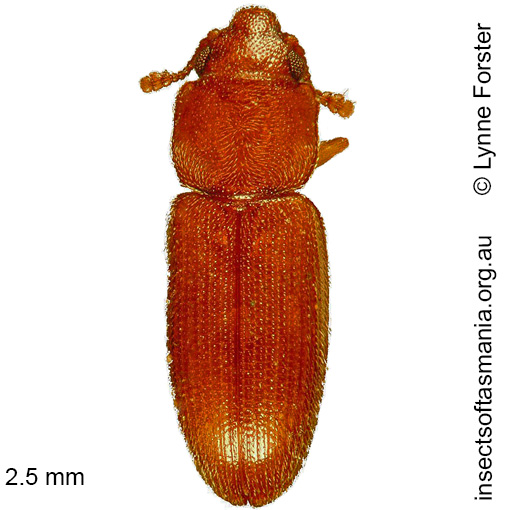
Myrabolia grouveliana (a species of myraboliid beetle)
Basis for Tasmanian occurrence
Semmens, T.D., McQuillan, P.B. & Hayhurst, G. (1992). Catalogue of the Insects of Tasmania. Government of Tasmania: Department of Primary Industry, 104 pp. (as Myrabolia grouvelliana; Myrabolia parva)
TMAG collections
Classification
Order: Coleoptera
Suborder: Polyphaga
Superfamily: Cucujoidea
Family: Myraboliidae
Morphology
Typical length (mm): 2.5
Flightedness: winged and assumed capable of flight
Source literature on morphology and taxonomy (*primary taxonomic source, where identified):
Tomaszewska, W. & Slipinski, S.A. (2008). A review of the genus Myrabolia Reitter (Coleoptera: Cucujoidea: Myraboliidae). Aust. J. Entom. 47 (1): 32-50.
Ecology
Assumed larval feeding: detritivore
Association with dead wood or old trees: at least facultatively saproxylic
Ecological attributes: — Affiliated with burnt tree-wounds (Harrison, 2007).
Collection method(s) for TMAG material: — Knockdown fogging of canopy of Eucalyptus obliqua — Knockdown spraying of bark of Eucalyptus sp. — Malaise trapping — Pitfall trapping — Sticky trapping on Eucalyptus obliqua — Vane trapping.
Source ecological literature:
Hopkins, A.J.M. et al. (2005). Wood decay fungi and beetle assemblages associated with living Eucalyptus obliqua trees: early results from studies at the Warra LTER Site, Ta
Grove, S.J. & Yaxley, B. (2005). Wildlife habitat strips and native forest ground-active beetle assemblages in plantation nodes in northeast Tasmania. Aust. J. Entom. 44 (4): 331-343.
Harrison, K.S. (2007). Saproxylic beetles associated with habitat features in Eucalyptus obliqua trees in the southern forests of Tasmania. PhD thesis, Dept. of Zoology, Univ. of Tasmania, Hobart.

